Are there any birds that live in the desert? The answer is yes! Despite the desert being a barren land with little to no plants and animals, some avians can survive in this harsh environment.
What bird species are we talking about? To name a few examples: the golden eagles, verdins, common ostriches, burrowing owls, ospreys, etc. What are the unique adaptations that enabled them to live in hot climates? Read on to know!
Table of Contents
Notable Desert Bird Species
More than a quarter of the world’s land is a desert ecosystem. That’s roughly over 57 million square miles!
The desert seems like an unlivable place with barely 10 inches of rain annually, but a few plants and animals inhabit this desolate area. In this desert birds list with names and pictures, we will introduce you to these avian species!
1. Golden Eagles
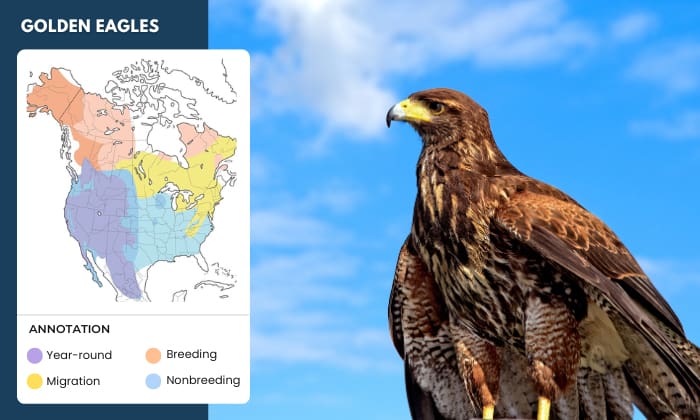
- Scientific Name: Aquila chrysaetos
- Weight Range: 3,000 to 6,125 grams
- Approximate Length: 70 to 84 centimeters
- Wingspan: 185 to 220 centimeters
Golden Eagles are large birds of prey as tall as 3 feet. They are known for their dark brown bodies, gold feathers on the nape, white tail base and underwing, and black beaks and claws. Both sexes have similar features, but males are smaller than females.
These desert eagles birds reside in the western parts of North America, North Africa, and Eurasia. Aside from deserts, you will find them in mountainous areas and open habitats like grasslands.
These predators survive in the desert by preying on animals and carrions. Golden Eagles are great hunters and will eat small birds and mammals, including livestock. They are also adept fliers, thanks to their impressive wingspan.
2. Verdin

- Scientific Name: Auriparus flaviceps
- Weight Range: 5 to 8 grams
- Approximate Length: 9 to 11 centimeters
- Wingspan: 16 to 17 centimeters
Verdins are small desert birds with mainly gray feathers, save for their yellow heads and auburn lesser coverts. The yellow on the males is more intense than on females and is completely absent in juveniles, who don’t have chestnut shoulder patches either.
These birds appear mostly in Mexico, such as Sonora and Chihuahuan desserts. However, you can also spot them in the US Dessert Southwest, like Mojave. The species prefer thorny shrubs and riparian over open lands with low vegetation.
These birds have adapted behaviors to escape the heat. Verdins will stay in shaded shrubs and nest toward the wind. Insects, spiders, nectars, and prickly pears provide them with the nutrients they need to survive.
3. Common Ostrich

- Scientific Name: Struthio camelus
- Weight Range: 63,000 to 145,000 grams
- Approximate Length: 170 to 280 centimeters
- Wingspan: 201 centimeters
These flightless birds are named the largest bird species. Common Ostriches are widely known for their long necks and legs, bulky bodies, clawed toes, large eyes, and sweeping eyelashes. Female ostriches are smaller than their male counterparts, and their plumage is mostly brown instead.
These Sahara desert birds are native to Africa, mainly in the southern parts. They can be found in vegetation, feeding on animal food, insects, desert plants, flowers, fruits, and lizards. Several predators hunt ostriches for food, and these birds use their strong legs to run away or sometimes play dead.
Common Ostriches have strong intestines that can digest a wide range of food and efficiently absorb nutrients. This, alongside their plant-rich diet, makes it possible for these birds to go without water for up to 2 weeks or more.
4. Greater Roadrunner
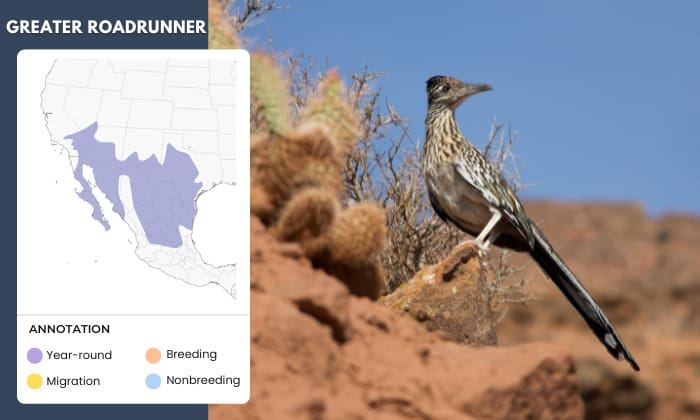
- Scientific Name: Geococcyx californianus
- Weight Range: 221 to 538 grams
- Approximate Length: 52 to 54 centimeters
- Wingspan: 49 centimeters
Greater Roadrunner is easily distinguishable by its unique shape: a long neck, long legs, and long, straight tails. Look for the blue skin around its eyes, white-spotted black crown, and tan plumage streaked with dark brown and black for further identification.
These runners can be found in the Sonoran desert, which spans across southeastern California, Arizona, Mexico, and Texas. You can also find these birds in US States like Arkansas, Missouri, Oklahoma, and Utah. Greater roadrunners generally prefer arid and open habitats, although they sometimes venture into light desert woodland as well.
The hot ground never bothers these birds, since they can move quickly while hunting for their prey. While running, their tail will bend upward. These birds’ diet primarily consists of insects and arthropods, although they also sometimes feed on small mammals, other birds, reptiles, and fruits.
5. Burrowing Owl
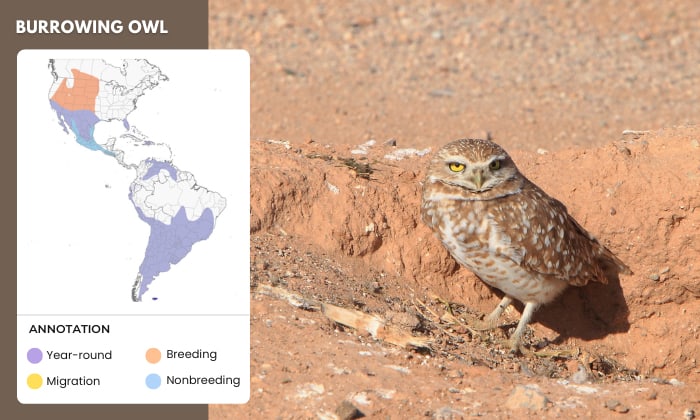
- Scientific Name: Athene cunicularia
- Weight Range: 140 to 240 grams
- Approximate Length: 19 to 28 centimeters
- Wingspan: 50.8 to 61 centimeters
This owl species is the smallest in North America. Some of its unmistakable features are its long legs, bright yellow eyes, and brown-spotted sandy plumage. Males have a lighter color and longer body shape than females.
Burrowing Owls are one of the many birds in the desert. They also frequent plains, fields, agricultural areas, and open habitats. You will find them roaming around these areas looking for small insects, moths, caterpillars, beetles, and even small animals.
These birds live in underground burrows, which can be either dug by other animals or themselves. They are active at dusk and midnight when small mammals are active.
6. Cactus Wren

- Scientific Name: Campylorhynchus brunneicapillus
- Weight Range: 32 to 47 grams
- Approximate Length: 18 to 22 centimeters
- Wingspan: 27.94 centimeters
The Cactus Wren is the largest wren in the United States. Its white-and-brown plump body comes with a long and heavy beak, short and rounded wings, and a curved tail. There’s little difference between the males and the females of this species.
These wrens are abundant and widely distributed in southwest deserts, inhabiting coastal sage scrubs, arid foothills, and urban areas. You can find them on yucca, saguaro cactus, mesquite, and prickly pear plants.
Cactus Wrens feed on fruits, seeds, beetles, grasshoppers, wasps, ants, and desert lizards. These birds can survive without drinking water, thanks to the food they eat.
7. Red-Tailed Hawk
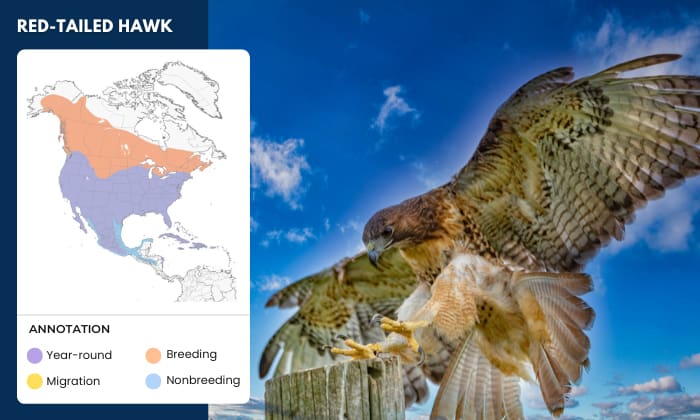
- Scientific Name: Buteo jamaicensis
- Weight Range: 690 to 1460 grams
- Approximate Length: 45 to 65 centimeters
- Wingspan: 114 to 133 centimeters
Red-tailed Hawks are large birds with short, wide tails and broad, rounded wings. Their plumage is mostly rich brown with white tips, streaked underside, and khaki red tails. Females tend to have darker tails and are also larger in size compared to their male counterparts.
This predatory bird is present across North America and is considered the most widespread hawk on the continent. They are highly adaptable and can live on marshes, coniferous forests, grasslands, foothills, and other open spaces.
Red-tailed Hawks have a varied diet, including reptiles, rabbits, ground squirrels, and small mammals. They are also opportunistic birds that will prey on any avian up to the size of a pheasant.
8. Gambel’s Quail
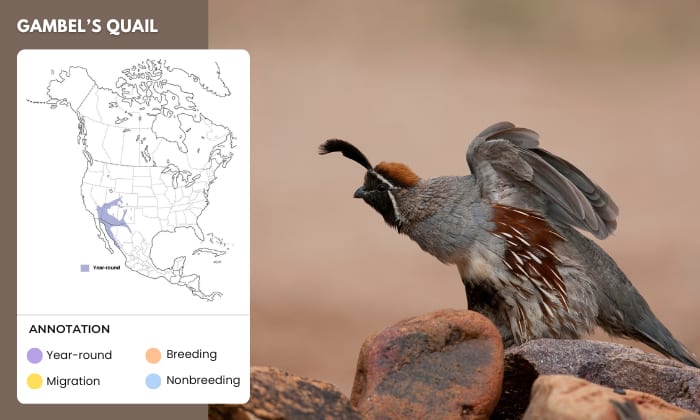
- Scientific Name: Callipepla gambelii
- Weight Range: 160 to 200 grams
- Approximate Length: 25 centimeters
- Wingspan: 34 to 36 centimeters
The round body, small beak, short neck, and square tail of this species are similar to other quails. Males are distinct with their scarlet crest, cream-colored underside with black patches, and auburn sides with white stripes. Females are mostly gray without the black belly and head pattern but with feather topknot.
Gambel’s Quail considers the Sonoran desert as its home. They are found in agricultural fields, shrublands, mesquite thickets, cacti, dry grasslands, desert streams, and waterholes. Their diet is heavily plant-based, but they feed on insects during breeding season.
The color pattern of this quail species makes it excellent for hiding itself to avoid its predators as long as it stays still.
9. Ospreys
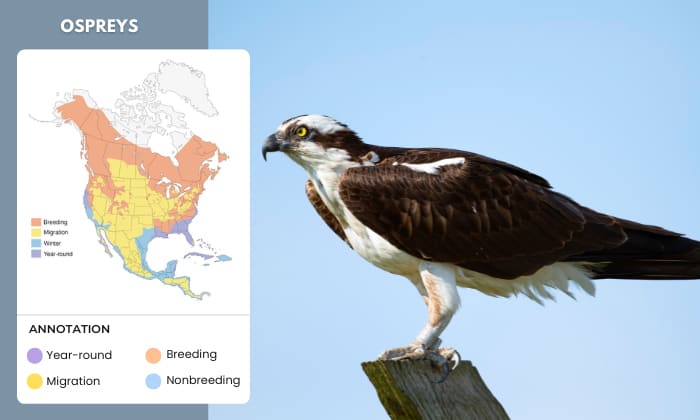
- Scientific Name: Pandion haliaetus
- Weight Range: 1,400 to 2,000 grams
- Approximate Length: 54 to 58 centimeters
- Wingspan: 150 to 180 centimeters
Ospreys are hawks with slender bodies, long legs, and narrow, extended wings. Their upper side is black, whereas their underside is white. The species also sport white head, brown eye stripe, and a distinct dark patch on the white wrist. You can distinguish immatures with the white specks on the back and chest shading.
These raptors breed in the northern regions of Canada and migrate to the deserts of the central and southwestern United States. You can spot them near bodies of water from rivers, reservoirs, salt marshes, estuaries, and ponds, fishing on the surface or diving underwater for fish. They also feed on salamanders, snakes, and small mammals.
Ospreys fly over deserts while migrating. They need water to survive the hot region; thus, they always find and hang around oases and desert lakes.
Conclusion
After knowing about the birds that live in the desert, aren’t you amazed by them? They surely are tough birds living in the desert and finding ways to survive, even with little food sources and a challenging climate.
Can you add more species to our list? Have you encountered any of them up close? Share what’s on your mind with us! It is always a pleasure to look through what our readers say.

George and I became friends after a birdwatching trip with our new group. And we have been enjoying every adventure together. When he told me the idea of establishing a site that shares our experiences and fun, I immediately agreed. After trials and errors, here we have Thayerbirding.














